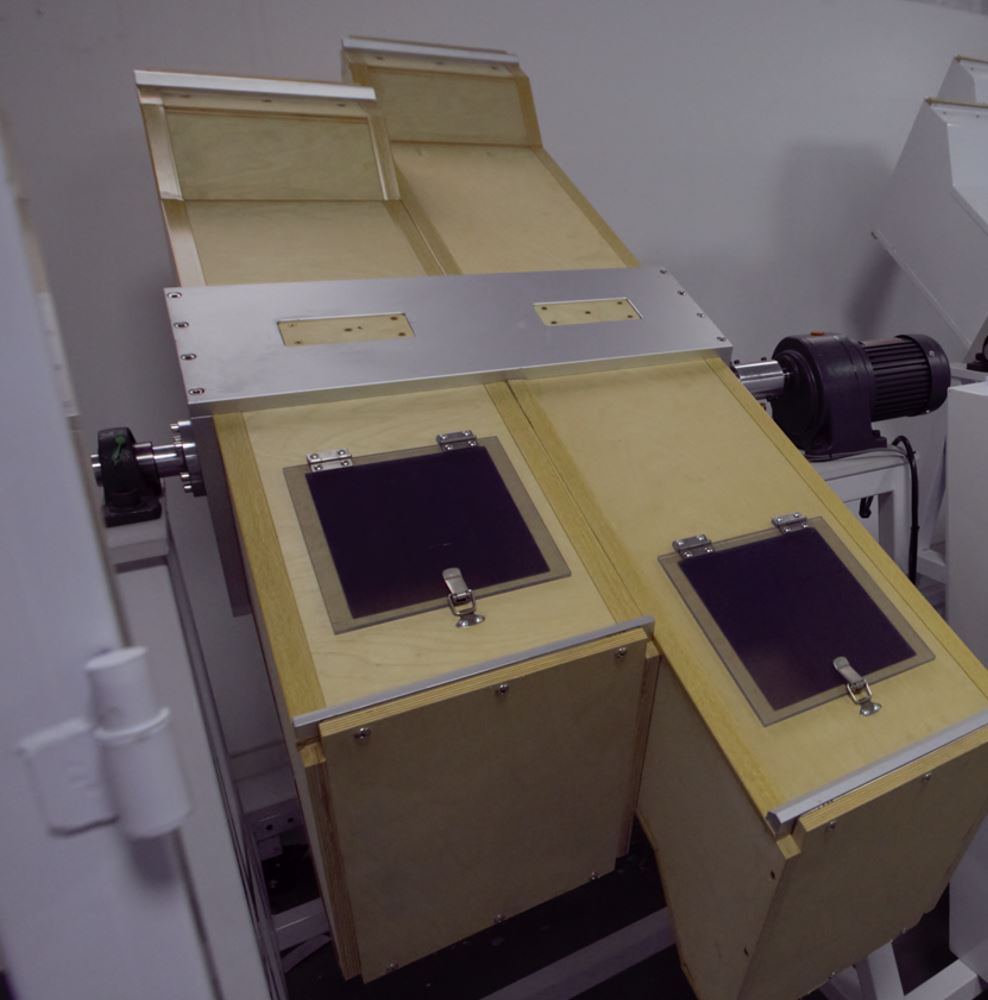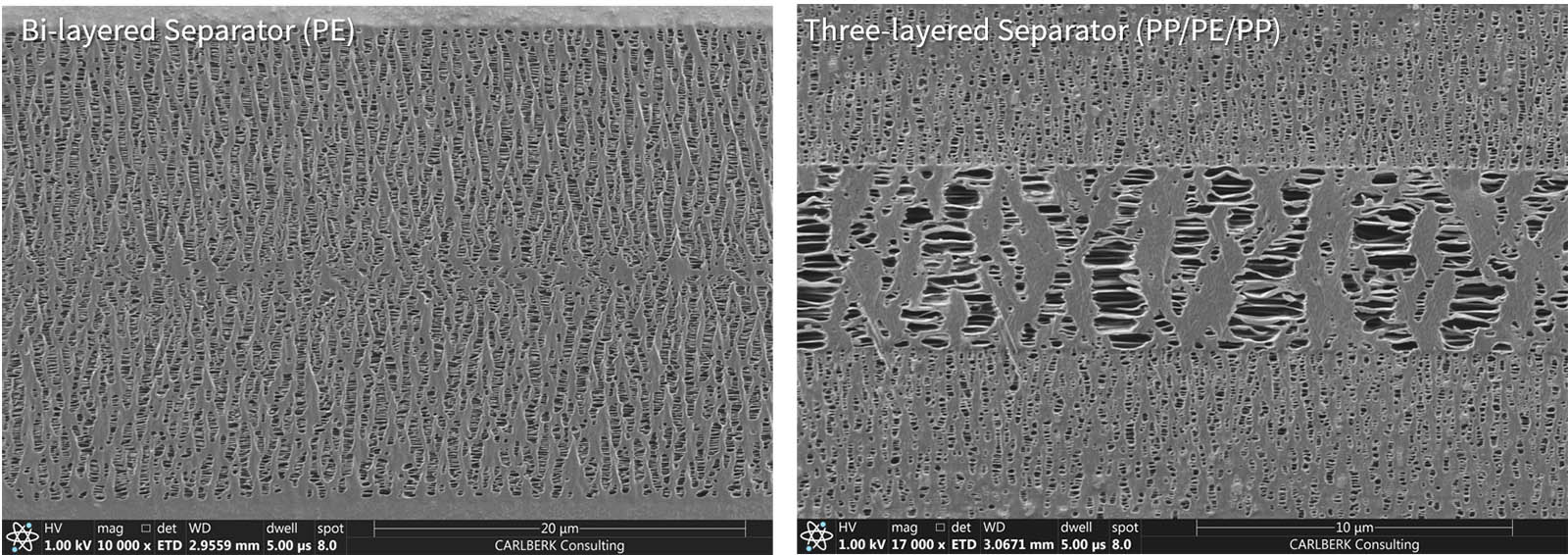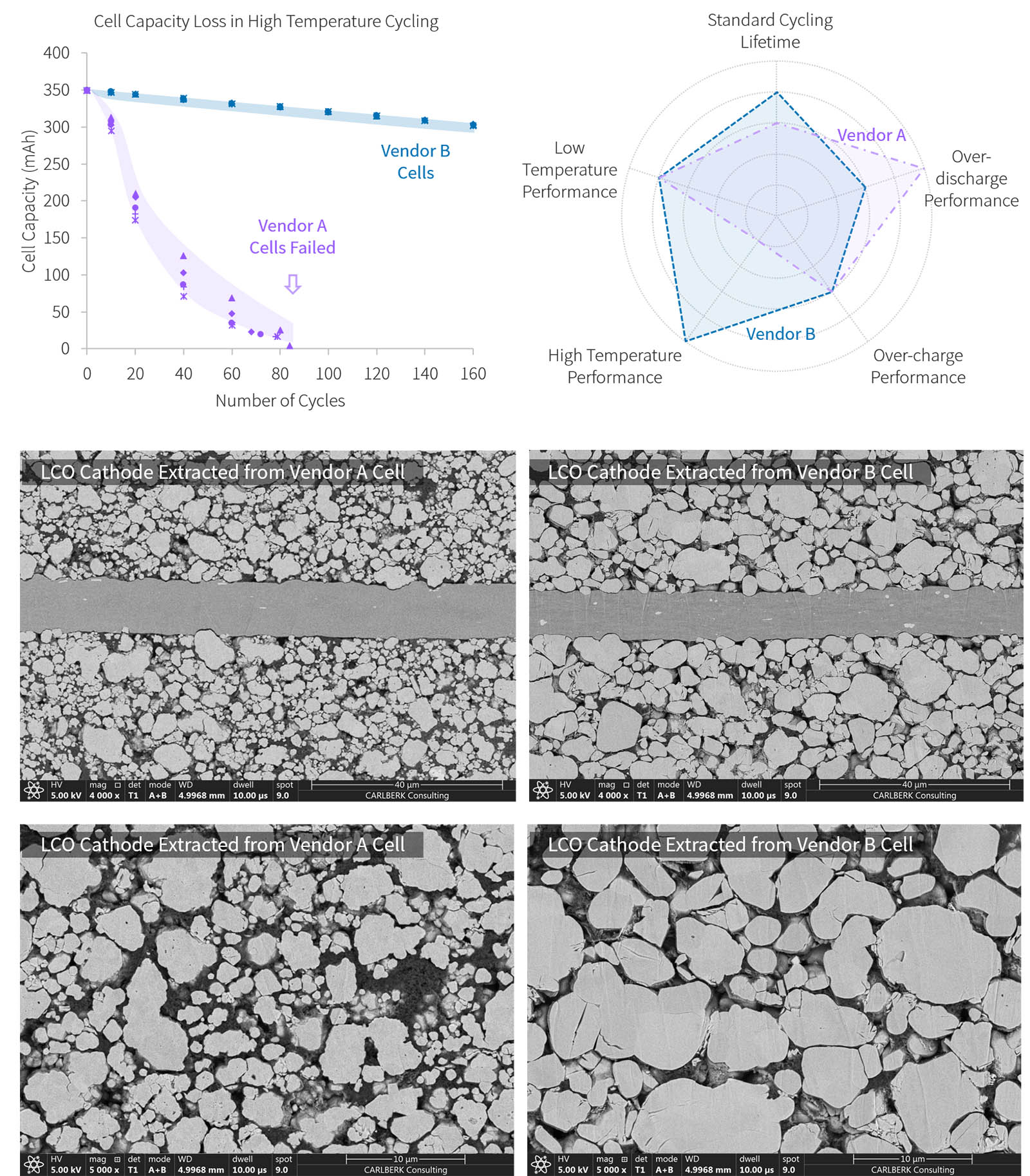Lithium-ion Batteries
Lithium-ion batteries are used widely in our daily life, from consumer electronics, power tools to electrical vehicles and energy storage plant. Due to the high energy density, the safety and reliability of lithium-ion batteries are always the top priority to consider before launching consumer products that contains batteries in them. However, the growing complexity in cell chemistry and constant evolvement of cell materials made the effective lithium-ion battery analysis challenging for traditional third-party labs.
CarlBerk focuses on helping our clients, especially those in medical devices, consumer electronics and light electrical vehicle industries to understand the performance, safety and reliability of the lithium-ion batteries sourced from outside vendor. CarlBerk has developed a suite of customized lithium-ion battery evaluation methodology and tool, providing a one-stop lithium-ion battery analytical service from pack to cell material level.
Lithium-ion Battery Performance Validation and Candidate Cell Selection
Battery performance validation is a vital part of consumer products development because it provides an understanding of the expected lifetime of a battery and how to safely use it. It can also identify any potential safety risks that may arise from using a battery that has not been adequately tested. By understanding the reliability of a battery, manufacturers and consumers can be assured that the product they are buying or using is of a high quality and has been sufficiently tested to provide a reliable, safe and long-lasting product.
CarlBerk has established a full fleet of battery cycling and unique electrical testing capabilities for our clients. With 2000+ cycler channels (Maccor, Neware), 100+ environmental chambers and various electrochemical analytical stations (Solartron, EnergyLab), we can deliver a wide variety of quick turnaround cycling tests and custom electrical tests at different conditions tailored to our clients’ needs.


Lithium-ion Batteries Reliability Assessment
Assessing the reliability of batteries is important because it enables us to understand how well the batteries can withstand under various extreme conditions and/or mechanical loads (or even under abuse), helping us to identify any potential safety issues that could arise from the use of the batteries.
At CarlBerk, we offer a comprehensive selection of battery reliability tests that are in compliance with international standards. This includes, but not limited to:
| Mechanical-related | Thermal-related |
|---|---|
| Drop Tests | High temperature High humidity |
| Vibration Tests | Extreme Temperature Storage |
| Tumble Tests | Thermal Cycling |
| Impact Tests | Thermal Shock |
Lithium-Ion Batteries Failure Analysis
Lithium-ion batteries could fail in many ways, from gradual loss of capacity, generation of swollen gas to more energetic ways, such as internal short and thermal runaway. Many of these were related to improper functioning of protective circuits, negligence in cell/host device manufacturing process, or in certain cases user abuse. Performing adequate failure analysis on the incident cells not only helped the OEMs to evaluate the risk in the filed, but also helped them to implement corrective actions in cell design and manufacturing process. CarlBerk utilize a full range of modern battery analytical tools and equipment, together with the expertise from the lithium-ion industry partners to help our client to understand the root cause(s) of cell failure.


Lithium-Ion Batteries Material Characterization
Although the formfactor of lithium-ion batteries appeared to be well-defined for decades, the material (sometime proprietary) used inside the lithium-ion batteries evolved fast. The classical lithium-ion battery material described in textbooks has been largely obsolete. Effective quality control and cell vendor selection lays upon thorough understanding of the cell, including its constituent materials, before and after certain usage.
CarlBerk is constantly developing advanced and useful analytical techniques with our partner cell manufacturers and research institutes, aiming at helping the users and cell manufacturers to better gauge their battery quality and performance. CarlBerk provide a full line of battery material characterization service including:
- Cell cathode/anode active material impurity concentration, particle size distribution
- Separator thickness and mechanical strength
- Ion cross-section analysis of electrode/binder/active material adhesion properties
- Active material cracking analysis (for NCM cathode materials)
- Active material area capacity evaluation
- Residual moisture and HF content in electrolyte
- Chemical analysis of gas generation
- Electrochemical Impedance Spectroscopy (EIS) on cell level and anode/cathode level
- Cryo-genic FIB analysis of material dispersion in battery slurry
Customized Battery Testing & Analysis
At CarlBerk, we have a team of talented and experienced problem solvers and a fleet of experimental tools to help our clients design a wide variety of customized experiments tailored to our clients’ needs. These customized experiments can be to study how much heat is generated from a battery cell during cycling, to evaluate venting trajectory of a battery in a device during forced thermal runaway, to evaluate if mechanical load on any part of a battery could result in electrical shorting, and many more other customized experiments.


Lithium-ion Batteries Manufacturer Audit
CarlBerk provides informative battery production line audit service to evaluate if good manufacturing procedures and quality control measures are implemented on cell/pack vendor site. Usually, such service is offered as part of our “Candidate Cell Testing and Selection Service”, in which we will specifically design the audit agenda and item list in accordance with the cell quality issue we discovered from the testing and analysis.
In a typical 1-2 days’ joint visit, CarlBerk consultants will walk through the cell production line with a check list that contained specific items to verify. The final audit report will present the factual findings and suggested corrective actions.
Example Cases
Example 1: Collapse of Jelly Roll Core 50x Low Temperature Cycles
High resolution CT scan revealed apparent welling and collapse of jelly roll core windings in an NCM Cell that showed soft internal leakage after 50 x low temperature cycles. Such mechanical damage was invisible from outside, however, it could induce leakage through damaged separator and as the severity progressed, a cell failure is inevitable.

Example 2: Battery Failure (Leakage) due to Corrosion of Cu Current Collector
Excessive internal corrosion and Cu current collector dissolution occurred as a result of cell over-discharge. The dissolved Cu re-deposited as Cu dendrite during subsequent charging and finally penetrated the separator.

Example 3: Analysis of Generated Gas in a Swollen Battery
A soft pouch lithium ion battery cell might abnormally generate internal gas and swell under some conditions. The root cause varies, such as over-charge, over-discharge, heating, low temperature cycling, ingress of moisture, or parasitic reaction due to electrolyte incompatibility. Analyzing the gas mixture extracted from the cell was a critical step to understand what factor(s) has triggered such failure event.

Example 4: Visualization of Internal Structure of Battery Separator
A separator is typically a thin porous polymer membrane. The pore volume should be carefully controlled to ensure efficient ionic conductivity and structural integrity. Cross-sectioning through ion milling at cryogenic temperature allows visualization of pore distribution without closing of pores due to local overheating.

Example 5: Comparison of Candidate Cells Sourced from Two Vendors
Even through the technical specification sheets looked similar, cells sourced from two vendors exhibit drastically different tolerance at elevated temperature. Detailed analysis of cell material revealed the different high temperature performance was correlated with different grade of LCO cathode materials used by the two vendors. In addition, CarlBerk provide more comprehensive comparison of two candidate cells from multiple aspects to assist client in cell selection.

